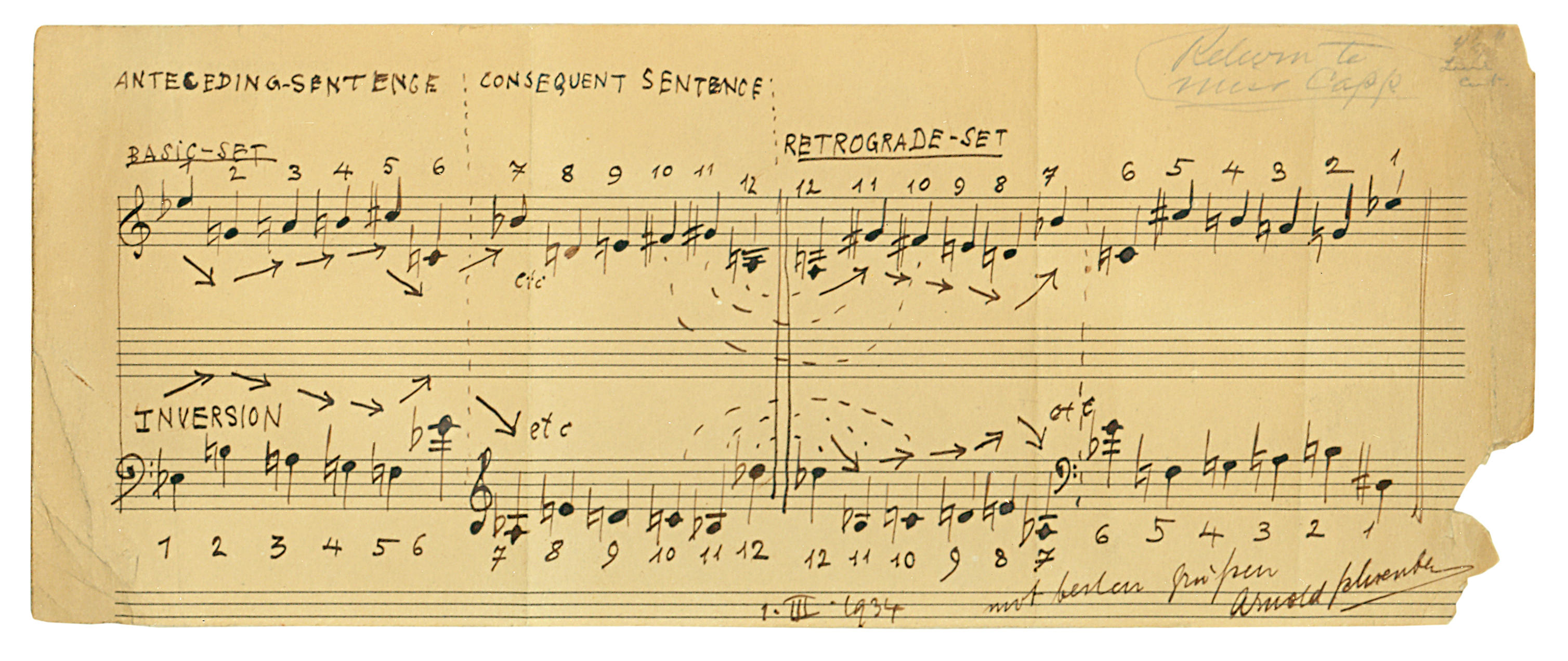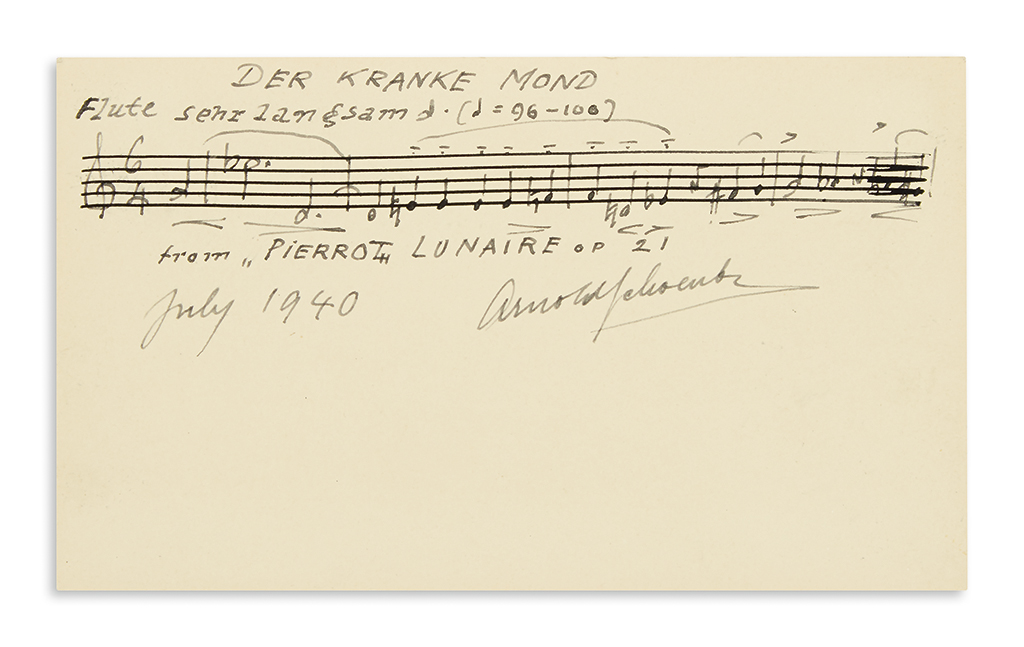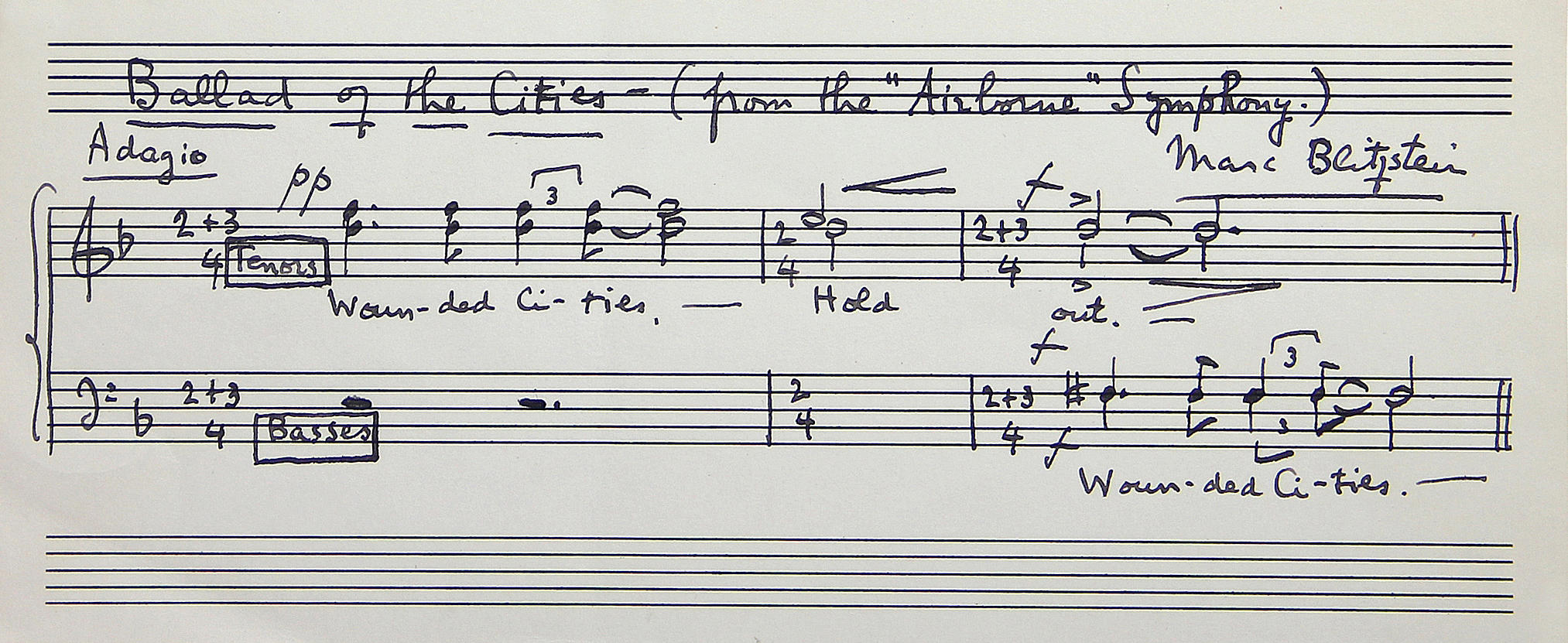SCHOENBERG, Arnold (1874-1951). Autograph musical manuscript inscribed and signed twice ("Arnold Schoenberg"), to Merle Armitage n.p., [written circa 1900], inscribed 25 February 1950. 2 pages, folio, 13 bars in ink on printed staves on recto, 7 bars in pencil on verso, boldly signed in ink on both sides. A LEAF FROM A WORKING DRAFT OF SCHOENBERG'S EARLY ATONAL MASTERPIECE "GURRELIEDER" An important fragment from a key early work. It was presented by the composer, a year before his death, to an old friend. The leaf contains 13 bars from a working draft in full score marked "Langsam" from his Gurrelieder (1900-1), scored for large chorus, soloists and orchestra. The recto carries a warm inscription: "To Mr. Merle Armitage as a souvenir reminder of pleasant contacts some years ago." In the early compositions Gurrelieder , and Verklärte Nacht (1899), Schoenberg expanded the chromatic style established by Wagner and Mahler. Gurrelieder depicts the love of King Waldemar and Tove under the Tristanesque imminence of death, Waldemar's blasphemous defiance of God after Tove's death, the night ride at the head of a ghostly retinue to which the king's restless spirit is subsequently condemned, and its dismissal by the summer wind at the approach of the day. The verso contains seven bars in score in pencil, entitled "Des Sommerwinders Wild Jagd," presumably from the last part of the work. Schoenberg encompassed his complexe narrative in a series of atmospheric tableaux reminiscent of Wagner's later operas (especially Götterdämmerung ). Schoenberg's twelve-tone technique, which revolutionized modern music by abandoning tonality (used to some extent in five piano pieces and a Serenade in 1923), was first employed in a complete work in 1924 in the Suite for Piano. After years in Berlin and in Vienna (where he founded in 1918 his famous private seminar in composition and the Society for Private Musical Performances, at which neither critics nor applause were allowed), he emigrated to the United States, teaching in Boston and in California during the 1930s-40s.
SCHOENBERG, Arnold (1874-1951). Autograph musical manuscript inscribed and signed twice ("Arnold Schoenberg"), to Merle Armitage n.p., [written circa 1900], inscribed 25 February 1950. 2 pages, folio, 13 bars in ink on printed staves on recto, 7 bars in pencil on verso, boldly signed in ink on both sides. A LEAF FROM A WORKING DRAFT OF SCHOENBERG'S EARLY ATONAL MASTERPIECE "GURRELIEDER" An important fragment from a key early work. It was presented by the composer, a year before his death, to an old friend. The leaf contains 13 bars from a working draft in full score marked "Langsam" from his Gurrelieder (1900-1), scored for large chorus, soloists and orchestra. The recto carries a warm inscription: "To Mr. Merle Armitage as a souvenir reminder of pleasant contacts some years ago." In the early compositions Gurrelieder , and Verklärte Nacht (1899), Schoenberg expanded the chromatic style established by Wagner and Mahler. Gurrelieder depicts the love of King Waldemar and Tove under the Tristanesque imminence of death, Waldemar's blasphemous defiance of God after Tove's death, the night ride at the head of a ghostly retinue to which the king's restless spirit is subsequently condemned, and its dismissal by the summer wind at the approach of the day. The verso contains seven bars in score in pencil, entitled "Des Sommerwinders Wild Jagd," presumably from the last part of the work. Schoenberg encompassed his complexe narrative in a series of atmospheric tableaux reminiscent of Wagner's later operas (especially Götterdämmerung ). Schoenberg's twelve-tone technique, which revolutionized modern music by abandoning tonality (used to some extent in five piano pieces and a Serenade in 1923), was first employed in a complete work in 1924 in the Suite for Piano. After years in Berlin and in Vienna (where he founded in 1918 his famous private seminar in composition and the Society for Private Musical Performances, at which neither critics nor applause were allowed), he emigrated to the United States, teaching in Boston and in California during the 1930s-40s.



.jpg)





Testen Sie LotSearch und seine Premium-Features 7 Tage - ohne Kosten!
Lassen Sie sich automatisch über neue Objekte in kommenden Auktionen benachrichtigen.
Suchauftrag anlegen